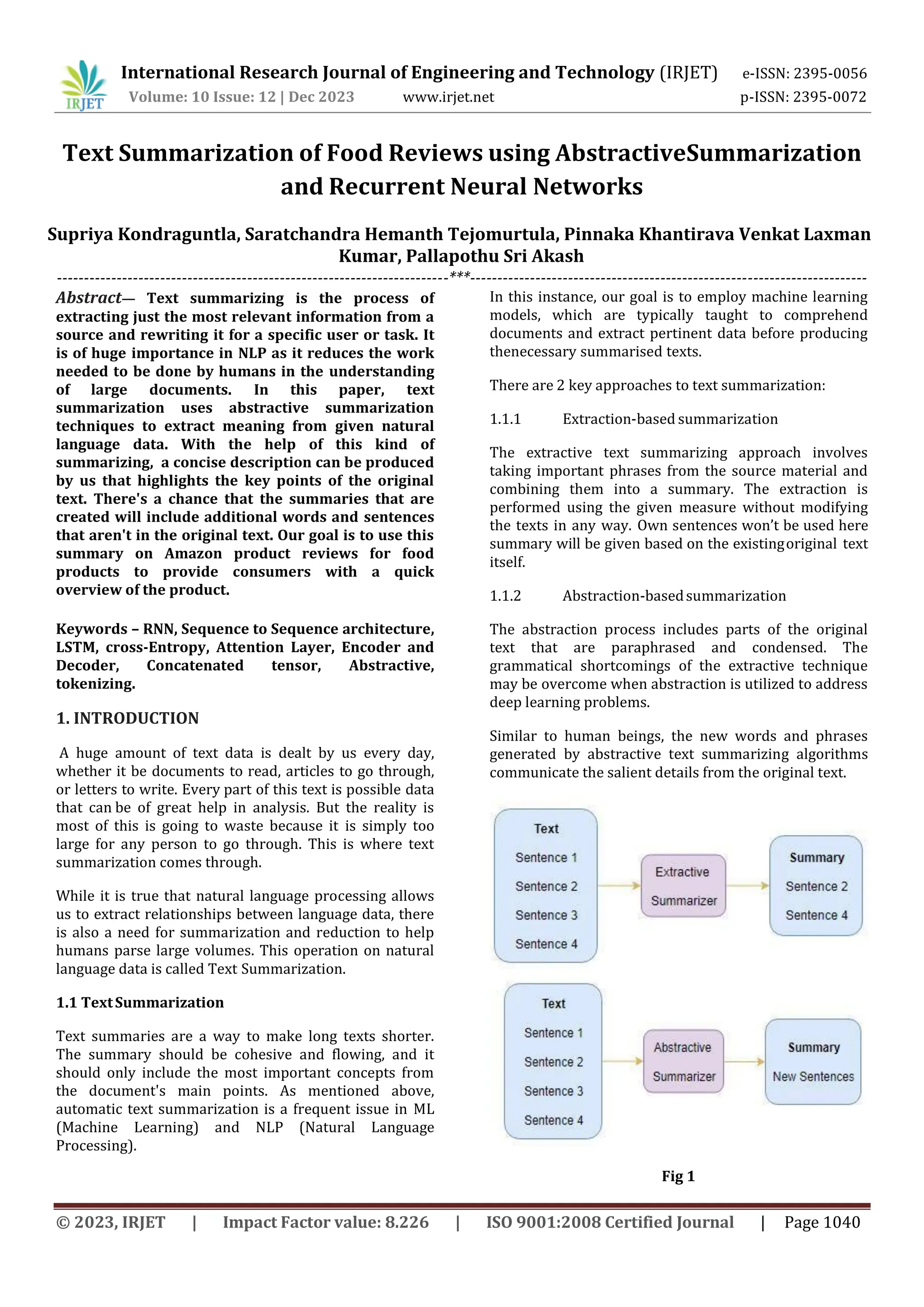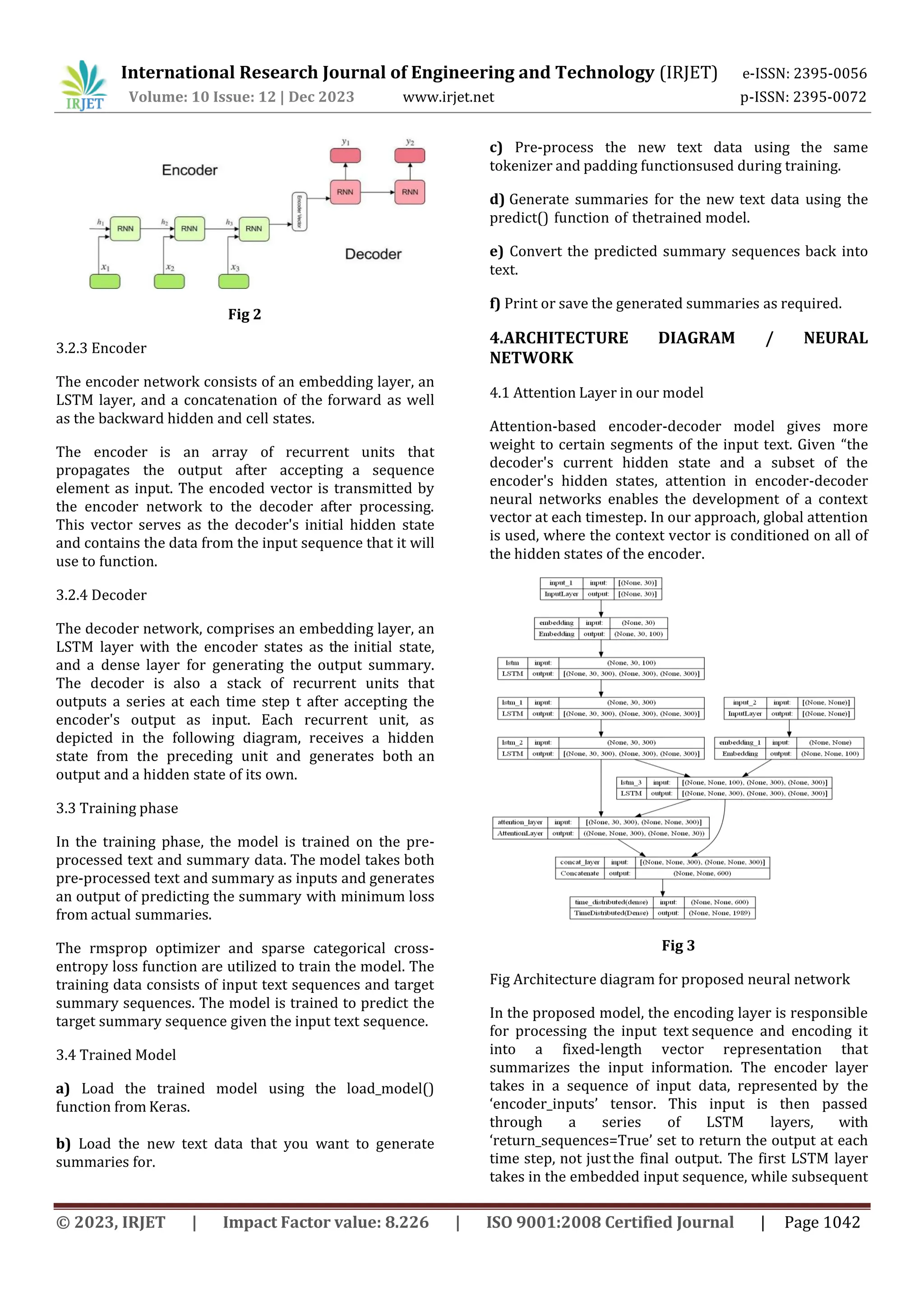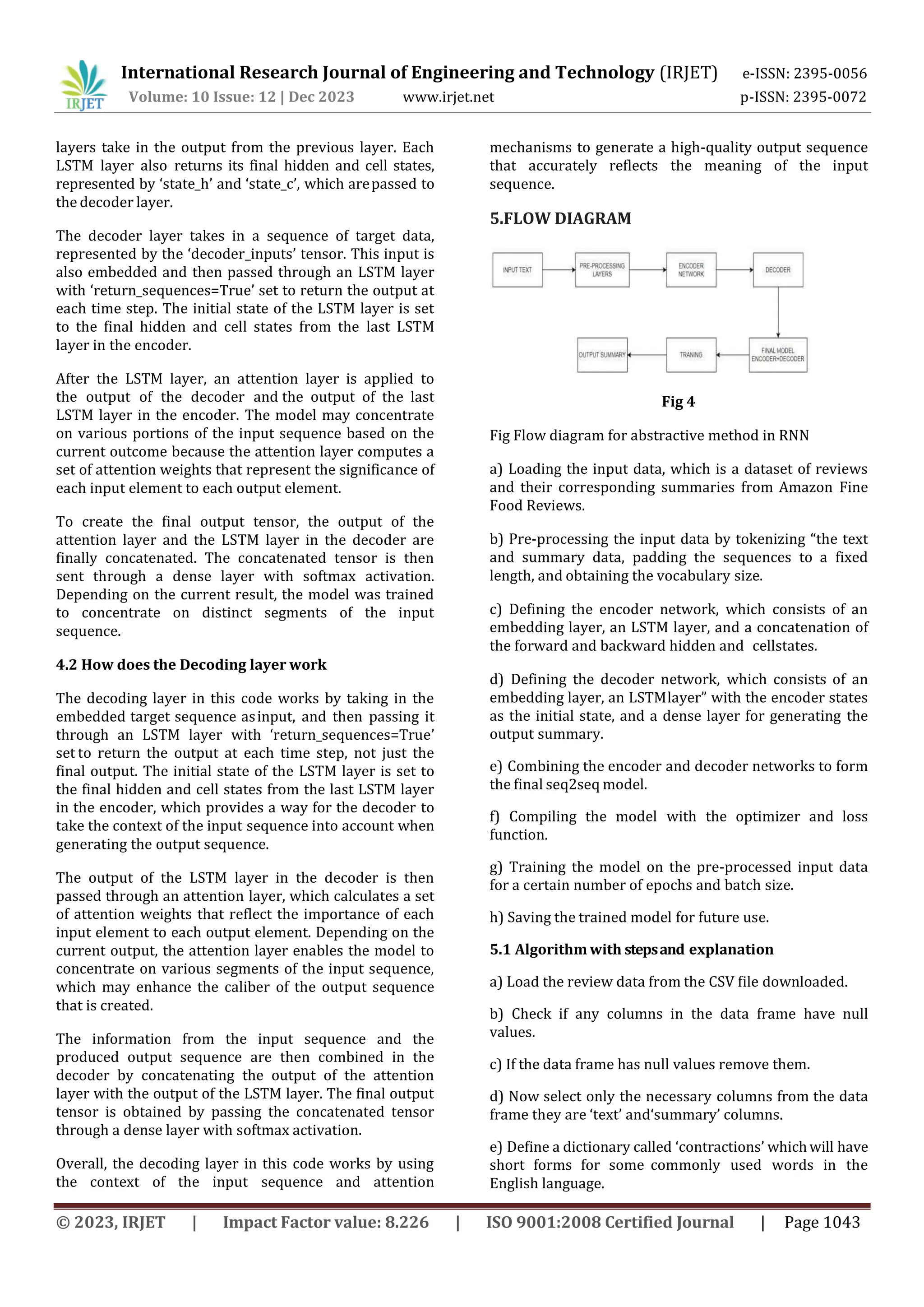The document describes a proposed method for conducting abstractive text summarization of food reviews using recurrent neural networks. The method involves preprocessing a dataset of Amazon food product reviews and summaries, then using an encoder-decoder neural network with attention mechanism to generate summaries. The encoder would encode the input text into a fixed-length vector, and the decoder would generate the summary sequence using the encoded vector and attention over the input sequence. The model would be trained on preprocessed input-summary pairs to minimize a loss function, and evaluated on its ability to generate accurate summaries of new reviews.




![International Research Journal of Engineering and Technology (IRJET) e-ISSN: 2395-0056
Volume: 10 Issue: 12 | Dec 2023 www.irjet.net p-ISSN: 2395-0072
© 2023, IRJET | Impact Factor value: 8.226 | ISO 9001:2008 Certified Journal | Page 1044
f) Now clean the text by removing unwanted
characters, a n d stopwords, and format the text to
create fewer null word embeddings.
a) Convert words to lowercase (Normalization).
b) Replace contractions with their longer forms.
c) Format words and remove unwanted characters.
d) Remove stopwords.
g) Add cleaned summaries and texts into a new list
respectively.
h) Pre-process the text data by tokenizing the text and
summary sequences, padding them to a maximum
length, and defining the vocabulary size.
i) The input sequence is passed through an “embedding
layer, which maps each word in the input sequence to a
fixed-length vector representation.
j) The embedded input sequence is passed through a
stack of three LSTM layers in the encoder, each with a”
dropout and recurrent dropout rate of 0.4, to generate a
sequence of encoded states.
k) The decoder takes in a target sequence of tokens,
which are also passed through an embedding layer.
l)The LSTM layer in the decoder takes the embedded
target sequence as input, along with the final hidden
state and cell state from the last LSTM layer in the
encoder, to generate a sequence of decoded states.
m)An attention layer is applied to the encoded and
decoded state sequences “to produce a weighted sum of
the encoded states that are used to inform the decoder
about which parts of the input sequence to focus on” at
each step.
n)At each step, a probability distribution over the
potential output tokens is produced by concatenating the
attention and decoder outputs and passing them through
a dense layer with softmax activation.
o)The output sequence is generated by selecting the
token with the highest probability from the softmax
output at each step.
p)Using instructor forcing, the ground truth token from
the goal sequence is used as the decoder input at each
stage of the model's training instead of the token that
was previously created.
q) The loss function utilized during training is the
categorical “cross-entropy loss, which compares the
predicted probability distribution over the output
tokens to the true distribution and penalizes the model
for making incorrectpredictions.
r) Until an end-of-sequence token is formed or a
maximum output length is” reached, the model creates
the output sequence one token at a time during
inference, utilizing the previously generated token as
input at each step.
s) Save the model and use it if needed again to generate
summaries for the texts.
6. RESULTS AND DISCUSSION
The Amazon Fine Foods dataset from Kaggle is utilized
by us. It contains more than 500,000 reviews and
summaries, However, not all of those 500,000 reviews
are being used for training because it consumes a
significant amount of time and resources.
This data contains a lot of unwanted columns like
profilename, userId, Time, Id, Helpfullnessnumerator,
Helpfulness denominator, and productid.
So, Those unwanted columns will be dropped from
our dataset, and only ‘text’ and ‘summary’ will be
selected from our dataset.
A lot of pre-processing like removing the stopwords,
normalization, lemmatization,
removing unwanted characters is done.
The below pre-processing tasks for our data will be
performed by us:
a. Convert everything to lowercase
Text = text.lower()
b. Remove HTML tags
Text = re.sub(r’<.*?>’, ‘’, text)
c. Contraction mapping
Contraction_mapping = {“don’t”: “do not”, “can’t”:
“cannot”, ...}
For word, replacement in contraction_mapping.items():
Text = text.replace(word, replacement)
d. Remove (‘s)
Text = text.replace(“(‘s)”, “”)
e. Remove any text inside the parenthesis ( )
Text = re.sub(r’(.*?)’, ‘’, text)
f. Eliminate punctuation and special characters
Text=re.sub(f”[{re.escape(string.punctuation)}]”, “”, text)](https://image.slidesharecdn.com/irjet-v10i12144-240112124015-fcdc7c4a/75/Text-Summarization-of-Food-Reviews-using-AbstractiveSummarization-and-Recurrent-Neural-Networks-5-2048.jpg)
![International Research Journal of Engineering and Technology (IRJET) e-ISSN: 2395-0056
Volume: 10 Issue: 12 | Dec 2023 www.irjet.net p-ISSN: 2395-0072
© 2023, IRJET | Impact Factor value: 8.226 | ISO 9001:2008 Certified Journal | Page 1045
g.Remove stopwords
Stop_words = set(stopwords.words(“english”))
Words = text.split()
Words = [word for word in words if word not in
stop_words]
h.Remove short words
Words = [word for word in words if len(word) > 2]
Reconstruct the pre-processed text
Preprocessed_text = ‘ ‘.join(words)
Return preprocessed_text
After defining the maximum length, the input text data
and summary data are tokenized using the Keras
Tokenizer class. Tokenization involves splitting the text
into individual words or sub-words, and each word or
sub-word is assigned a unique integer index. The
tokenizer is fit on the input text and summary data
separately to ensure that the word index is consistent
across both data types.
Fig 5 Graphical comparision b/w input text vs output
summary
Fig 6 Graphical comparision b/w training dataset and
testing dataset
Finally, the tokenized data is converted into sequences of
integers and padded to ensure that each sequence has
the same length. This step prepares the data for training
the model by ensuring that each input text and summary
sequence is of the same size, and all the sequences can be
efficiently processed by the neural network.
Performance metrics
Algorithm
Name
Values obtained by
Abstractive
Summarization
Values obtained by
Extractive
Summarization
ROUGE-1 0.45 0.65
ROUGE-2 0.30 0.50
ROUGE-L 0.40 0.60
F1-Score 0.60 0.70
Precision 0.15 0.75
Recall 0.75 0.65
Time 2.5s per review 2.2s per review
Memory 512MB 512MB
7.CONCLUSION
Reading long and unwanted info in revies is a trouble for
the modern world’s generation and a time waste
process. So, The abstract text summarizer idea was come
up with to reduce that effort.
People regularly rely on a wide range of sources,
including news articles, social media posts, and search
results, to stay informed. Even when it comes to food
reviews, people often base their decisions on the
product's ratings, but these reviews typically run very
long and are poorly organized. Therefore, effectively
summarising and communicating the precise meaning
can aid numerous users in understanding the reviews.
Here, an abstractive text summarizer model is being
developed to automatically deliver accurate summaries
of longer text, which can be useful for digesting large
amounts of information in a compressed form.
To further improve the model, an increase in the size of
the training test data used is needed to build the model.
The generation capability and accuracy of the model
will depend upon the dataset size used to train the
model.
Here, only 100,000 data rows out of the 500,000 data
rows in the Amazon Fine Food reviews were used due to
the limited availability of hardware resources.
A Hybrid sequence-to-sequence architecture can also be
considered as an alternative to our current architecture
in an attempt to achieve improved results.
8.REFERENCES
[1] Song, S., Huang, H. And Ruan, T., 2019. Abstractive
text summarization using LSTM-CNN based deep](https://image.slidesharecdn.com/irjet-v10i12144-240112124015-fcdc7c4a/75/Text-Summarization-of-Food-Reviews-using-AbstractiveSummarization-and-Recurrent-Neural-Networks-6-2048.jpg)
![International Research Journal of Engineering and Technology (IRJET) e-ISSN: 2395-0056
Volume: 10 Issue: 12 | Dec 2023 www.irjet.net p-ISSN: 2395-0072
© 2023, IRJET | Impact Factor value: 8.226 | ISO 9001:2008 Certified Journal | Page 1046
learning. Multimedia Tools and Applications, 78, pp.857-
875.
[2] Hanunggul, P.M. and Suyanto, S., 2019, December.
The impact of local attention in lstm for abstractive text
summarization. In 2019 International Seminar on
Research of Information Technology and Intelligent
Systems (ISRITI) (pp. 54-57). IEEE.
[3] Suleiman, D. And Awajan, A., 2020. Deep learning
based abstractive text summarization: approaches,
datasets, evaluation measures, and challenges.
Mathematical problems in engineering, 2020, pp.1-29.
[4] Rahman, M.M. and Siddiqui, F.H., 2019. An optimized
abstractive text summarization model using peephole
convolutional LSTM. Symmetry, 11(10), p.1290.
[5] Raphal, N., Duwarah, H. And Daniel, P., 2018, April.
Survey on abstractive text summarization. In 2018
international conference on communication and signal
processing (ICCSP) (pp. 0513-0517). IEEE.
[6] Batra, P., Chaudhary, S., Bhatt, K., Varshney, S. And
Verma, S., 2020, August. A Review: Abstractive Text
Summarization Techniques using NLP. In 2020
International Conference on Advances in Computing,
Communication & Materials (ICACCM) (pp. 23-28). IEEE.
[7] Zaki, A.M., Khalil, M.I. and Abbas, H.M., 2019,
December. Deep architectures for abstractive text
summarization in multiple languages. In 2019 14th
International Conference on Computer Engineering and
Systems (ICCES) (pp. 22-27). IEEE.
[8] Masum, A.K.M., Abujar, S., Talukder, M.A.I., Rabby,
A.S.A. and Hossain, S.A., 2019, July. Abstractive method of
text summarization with sequence to sequence RNNs. In
2019 10th international conference on computing,
communication and networking technologies (ICCCNT)
(pp. 1-5). IEEE.
[9] Jiang, J., Zhang, H., Dai, C., Zhao, Q., Feng, H., Ji, Z. And
Ganchev, I., 2021. Enhancements of attention-based
bidirectional lstm for hybrid automatic text
summarization. IEEE Access, 9, pp.123660-123671.
[10] Talukder, M.A.I., Abujar, S., Masum, A.K.M., Faisal, F.
And Hossain, S.A., 2019, July. Bengali abstractive text
summarization using sequence to sequence RNNs. In
2019 10th International Conference on Computing,
Communication and Networking Technologies (ICCCNT)
(pp. 1-5). IEEE.
[11] Doǧan, E. And Kaya, B., 2019, September. Deep
learning based sentiment analysis and text
summarization in social networks. In 2019 International
Artificial Intelligence and Data Processing Symposium
(IDAP) (pp. 1-6). IEEE.
[12] Rekabdar, B., Mousas, C. And Gupta, B., 2019,
January. Generative adversarial network with policy
gradient for text summarization. In 2019 IEEE 13th
international conference on semantic computing (ICSC)
(pp. 204-207). IEEE.
[13] Day, M.Y. and Chen, C.Y., 2018, July. Artificial
intelligence for automatic text summarization. In 2018
IEEE International Conference on Information Reuse and
Integration (IRI) (pp. 478-484). IEEE.
[14] Al Munzir, A., Rahman, M.L., Abujar, S. And Hossain,
S.A., 2019, July. Text analysis for Bengali text
summarization using deep learning. In 2019 10th
International Conference on Computing, Communication
and Networking Technologies (ICCCNT) (pp. 1-6). IEEE.
[15] Siddhartha, I., Zhan, H. And Sheng, V.S., 2021,
December. Abstractive Text Summarization via Stacked
LSTM. In 2021 International Conference on
Computational Science and Computational Intelligence
(CSCI) (pp. 437-442). IEE
[16] El-Kassas, W.S., Salama, C.R., Rafea, A.A. and
Mohamed, H.K., 2021. Automatic text summarization: A
comprehensive survey. Expert systems with
applications, 165, p.113679.
[17] Nenkova, A. And McKeown, K., 2012. A survey of
text summarization techniques. Mining text data, pp.43-
76.
[18] Liu, Y. And Lapata, M., 2019. Text summarization
with pretrained encoders. arXiv preprint
arXiv:1908.08345.
[19] Steinberger, J. And Ježek, K., 2009. Evaluation
measures for text summarization. Computing and
Informatics, 28(2), pp.251-275.
[20] Gupta, V. And Lehal, G.S., 2010. A survey of text
summarization extractive techniques. Journal of
emerging technologies in web intelligence, 2(3), pp.258-
268.
[21] Kryściński, W., McCann, B., Xiong, C. And Socher, R.,
2019. Evaluating the factual consistency of abstractive
text summarization. arXiv preprint arXiv:1910.12840.
[22] Li, P., Lam, W., Bing, L. And Wang, Z., 2017. Deep
recurrent generative decoder for abstractive text
summarization. arXiv preprint arXiv:1708.00625.
[23] Alomari, A., Idris, N., Sabri, A.Q.M. and Alsmadi, I.,
2022. Deep reinforcement and transfer learning for
abstractive text summarization: A review. Computer
Speech & Language, 71, p.101276.](https://image.slidesharecdn.com/irjet-v10i12144-240112124015-fcdc7c4a/75/Text-Summarization-of-Food-Reviews-using-AbstractiveSummarization-and-Recurrent-Neural-Networks-7-2048.jpg)
![International Research Journal of Engineering and Technology (IRJET) e-ISSN: 2395-0056
Volume: 10 Issue: 12 | Dec 2023 www.irjet.net p-ISSN: 2395-0072
© 2023, IRJET | Impact Factor value: 8.226 | ISO 9001:2008 Certified Journal | Page 1047
[24] Yao, K., Zhang, L., Du, D., Luo, T., Tao, L. And Wu, Y.,
2018. Dual encoding for abstractive text summarization.
IEEE transactions on cybernetics, 50(3), pp.985-996.
[25] Talukder, M.A.I., Abujar, S., Masum, A.K.M., Akter, S.
And Hossain, S.A., 2020, July. Comparative study on
abstractive text summarization. In 2020 11th
International Conference on Computing, Communication
and Networking Technologies (ICCCNT) (pp. 1-4). IEEE.
[26] Modi, S. And Oza, R., 2018, September. Review on
abstractive text summarization techniques (ATST) for
single and multi documents. In 2018 International
Conference on Computing, Power and Communication
Technologies (GUCON) (pp. 1173-1176). IEEE.
[27] Yeasmin, S., Tumpa, P.B., Nitu, A.M., Uddin, M.P., Ali,
E. And Afjal, M.I., 2017. Study of abstractive text
summarization techniques. American Journal of
Engineering Research, 6(8), pp.253-260.
[28] Wang, L., Yao, J., Tao, Y., Zhong, L., Liu, W. and Du, Q.,
2018. A reinforced topic-aware convolutional sequence-
to-sequence model for abstractive text
summarization. arXiv preprint arXiv:1805.03616.
[29] Huang, Y., Feng, X., Feng, X. and Qin, B., 2021. The
factual inconsistency problem in abstractive text
summarization: A survey. arXiv preprint
arXiv:2104.14839.
[30] Khan, A., Salim, N., Farman, H., Khan, M., Jan, B.,
Ahmad, A., Ahmed, I. and Paul, A., 2018. Abstractive text
summarization based on improved semantic graph
approach. International Journal of Parallel programming ,
46, pp.992-1016.](https://image.slidesharecdn.com/irjet-v10i12144-240112124015-fcdc7c4a/75/Text-Summarization-of-Food-Reviews-using-AbstractiveSummarization-and-Recurrent-Neural-Networks-8-2048.jpg)